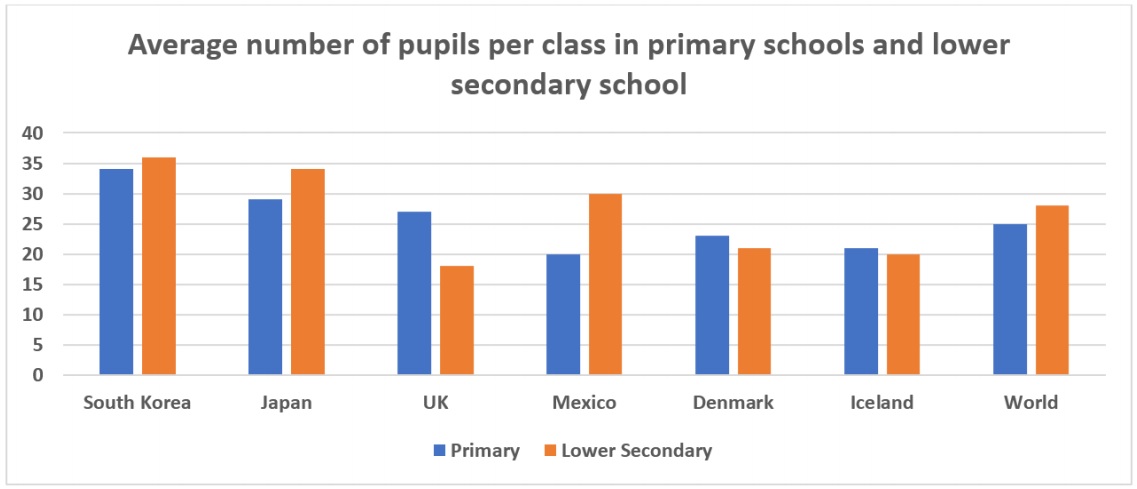The bar chart shows the average size class in primary schools and lower secondary schools in 6 countries compared to the world average in 2006.
Write at least 150 words.

WRITING TASK 2
You should spend about 40 minutes on this task
Write about the following topic:
More and more people want to buy clothes, cars and other items from famous brands. What are the reasons? Do you think it is a positive or negative development?
Give reasons for your answer and include any relevant examples from your own knowledge or experience.
Write at least 250 words.
WRITING TASK 1
The bar chart illustrates the average class size in primary and secondary schools in six different countries, and compares these figures with the world average.
In general, the world average number of pupils in a lower secondary school class was higher than the figure for primary schools. In addition, Asian countries (South Korea and Japan) had a higher number of students on average in classrooms compared with other countries.
In 2006, South Korea, Japan, and the UK all had larger primary school classes when compared with the world average. South Korea had the largest primary school classes, at around 34 students per class. On the other hand, Mexico, Denmark, and Iceland all had smaller than world average primary school classes, at 20, 23, and 21 students per class respectively.
With regards to lower secondary school classes, South Korea, Japan, and Mexico, all had higher than world average class sizes, with South Korea again having the largest classes, at an average of 36 students per class. The UK, Denmark, and Iceland, all had smaller than world average classes, with 18, 21, and 20 students per class respectively.
(186 words – Band 8.0)
WRITING TASK 2
Nowadays, purchasing items such as cars or clothes from famous brands is becoming increasingly popular among a large number of people. The reasons behind this trend will be outlined in the following essay and, in my opinion, it could bring both positive and negative consequences in equal measure.
To begin with, the tendency of using large brand products mostly stems from people’s beliefs on personal possessions reflecting wealth, social status, and appearance. More specifically, many people associate clothes and accessories from popular brand names such as Nike or Adidas with high quality and fashionable designs. Therefore, these items are more suitable for enhancing people’s appearance than the products from smaller brands. In addition, some types of goods like cars from luxurious brands are usually sold at exorbitant prices because of their expensive materials or unique features. Hence, these items are often considered as a tool for the rich to show off their social status or their wealth.
On the other hand, more people purchasing goods from famous brands can bring both merits and drawbacks to the business world. Countries where famous brands are based are more likely to have a strong and healthy economy. For instance, the US – the home country of many large brands, such as Apple and Microsoft, has been the strongest economic superpower since the late 20th century partly since the products of these enterprises are favored not only in domestic but also in foreign markets. However, the rise of dominant brand names can be a factor leading to monopoly as large companies will attempt to dominate and finally wipe out smaller rivals to maintain their positions.
In conclusion, the tendency of consuming goods from famous brands largely comes from people’s perception of personal belongings showing their wealth, social status and appearance. This trend can bring both positive and harmful effects to the business market and, therefore, should be well-considered by the government to prevent largescale monopoly.
(321 words – Band 8.0)
